| Dec-08-18 | | Captain Hindsight: Better would have been <34... Qb3!!> winning the a-pawn 
click for larger view
or if <35.Bb2 b4!> |
|
Nov-19-22
 | | KEG: Teichmann was doing reasonably well on the scoreboard as he sat down to play this 12th round game against Albin. He had, apart from Marocy, yielded the fewest points, and ultimately finished in fourth place. But the even was nonetheless beating him down. He was one of only two players (Gunsberg being the other) who had yet to have a bye. Thus, he had not had a break from playing in Rounds 1-12. By contrast, five of his competitors had enjoyed two days off. Nor did Teichmann have much relief coming. While he would eventually get two bye rounds, with his draw here against Albin Teichmann now had FOUR games to replay. No other competitor had more than two, and most of the others in the top half of the scoreboard had either no replays or--at most--one. Small wonder that in the closing rounds Teichmann lost to Marshall and Janowski and missed finishing in the top three. Teichmann had played Albin twice before, losing two and drawing one. After this draw, Teichmann won his remaining three games lifetime against Albin, one of which--his victory in their replay eight days after this game--is not included in the totals for their rivalry on this site (probably because the game score is not available. This game was curious. Albin played the Albin Counter-Gambit. Teichmann made no serious effort to obtain an edge in this opening, yet Albin mishandled the opening that bears his name and had the worst of the struggle, reaching a likely theoretically losing position after his misguided 18th move. But then Teichmann went astray and--despite Bishops of opposite colors--was probably lost. But just as Albin seemed poised to win, he unaccountably traded Queens allowing Teichmann to reach a Bishop of opposite colors ending that--with some clever endgame tactical surprises--he was able to draw. Teichmann's play here once the Queens were off the board redeems what would otherwise have been a very lackluster game. 1. d4 d5
2. c4 e5
Albin playing the Albin Counter-Gambit!
3. e3

click for larger viewThe normal 3.dxe5 is much better and gives White good play, Black having to fight for counter-play after 3...d4. But Teichmann did not seem eager to enter into the complexities of the gambit, and tried the quieter and unambitious 3. e3. If, however, he thought that by so doing he would avoid surprises, Albin's next move must have taken him aback: 3... Bb4+?!
"?"--(Tournament Book)
So far as I can tell, this move has not otherwise been played either before this game or after. Black, as Albin of all people should have known, gets a good game with at least even chances with 3...exd4 (and then 4...Bb4+). The text hands the edge to White. 4. Nc3
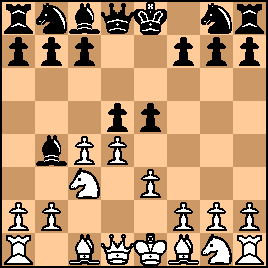
click for larger view4... e4?!
"?"--(Tournament Book)
4...exd4 now no longer equalizes for Black since White can now comfortably play5. Qxd4. Albin's move courted trouble.
5. cxd5 Qxd5
5...BxN+ immediately is no better for Black. The text left Teichmann with opportunities to obtain much the better position, the board now showing: 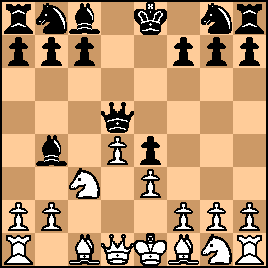
click for larger view6. Bd2
More solid but unambitious play by Teichmann. After, for example, 6. Nge2 Nf6 7. a3 BxN+ 8. NxB he would have emerged from the opening far better placed than Albin. The text should have allowed Albin to achieve a decent position.. 6... BxN
7. bxB a5?!
This ended up working fine for Albin, but only because Teichmann made no effort to punish Black's questionable opening play. 7...Nf6 or 7...Qd6 were superior to the text. 7...c5 is an interesting alternative. After 7...a5, the position was: 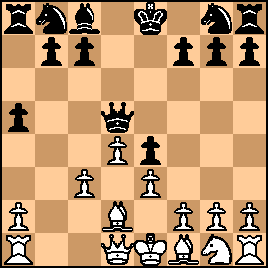
click for larger view |
|
Nov-20-22
 | | KEG: Post II
8. f3?
More placid play by Teichmann, who apparently only sought a playable game rather than considering the more critical and potentially powerful moves such as 8. c4 or 8. Ne2 (to be followed by 9. Ng3). The Tournament Book's suggested 8. Qb3 is not as good as these last two choices, but even that was better than Teichmann's solid but uninspiring 8. f3. 8... Nf6
Albin had now nearly equalized.
9. Qb3 Qd6
Trading Queens would leave White with a definitely superior game. After Albin's actual 9...Qd6, the position was: 
click for larger view10. Bc1
The Tournament Book faulted Teichmann's unsuccessful effort to play Ba3, but its suggested 10. a4 allows Black full equality with 10...0-0. 10... a4
Pressing hard. Perhaps the simple developing 10...Nbd7 was best. In either case, Teichmann would have only a small edge. 11. Qc2 Qe7
12. fxe4 Nxe4
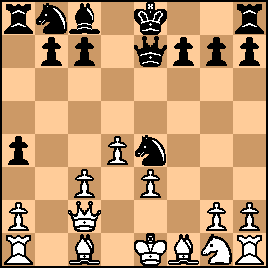
click for larger viewSo Teichmann emerged with a tiny advantage (most notably the two Bishops and control of the center) and a safe position, while Albin had also survived basically intact. 13. Nf3 0-0
14. Bd3 f5
Achieving the set-up toward which he appeared to have been aiming. 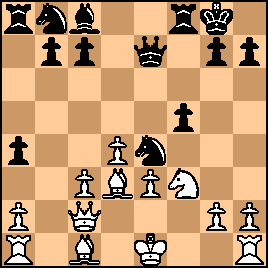
click for larger view15. 0-0 Nd7
16. Rb1 c6
17. c4
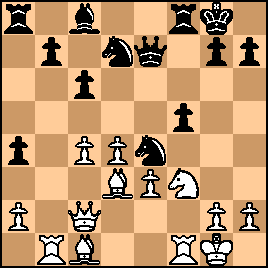
click for larger view17... h6?!
With 17...Ndf6, Albin would have survived the opening intact. But now he itched for more, and promptly got into trouble: 18. g3 g5?!
Albin should have settled for 18...g6, but it appears he misjudged the position and thought he could launch a King-side assault. The position now, however, afforded Teichmann chances to obtain a powerful--and perhaps winning--initiative: 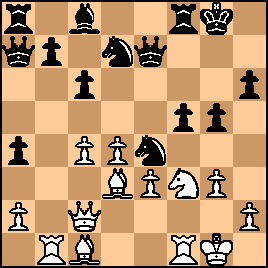
click for larger view19. Bd2?
Missing his chance: 19. g4! fxg4 20. BxN gxN 21. Bxf3 with excellent attacking (and winning) chances. 19... c5!
Suddenly, Albin was very much back in the game:

click for larger viewTeichmann had squandered his chance to try to land a knock-out blow, but his position was still entirely sound. Beginning here, however, he seemed to lose the thread of the game and turned the initiative over to Black, and then landed himself in what was at least close to a losing position. |
|
Nov-20-22
 | | KEG: Post III
20. BxN?
Hard to believe from a player of Teichmann's caliber. He gave up the advantage of the two Bishops and turned over the initiative entirely to Albin. By means of 20. Bc1! followed by 21. Nd2, Teichmann would have retained the advantage he had held through almost all of the game to this point. There were also other ways to keep his edge. From this point through the end of the game, Teichmann had to struggle to keep his head above water. 20... fxB
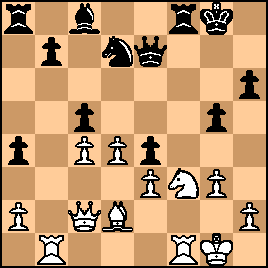
click for larger viewThe situation had obviously changed and Albin, though nowhere close to a win just yet, was plainly in the ascendancy. 21. Ne5?
This results in weak advance e-pawn for White. As unpleasant as it must have been, Teichmann should have gritted his teeth and played 21. Ne1. 21... RxR+
22. RxR NxN
23. dxN

click for larger viewIf Teichmann was not lost here it was only because of the potentially equalizing effect of Bishops of opposite colors. 23... Bh3!
24. Rf6
There was nothing better for White.
24... Rf8

click for larger view25. Bc3
25. Qxa4 would have been no better; e.g., 25...RxR 26. exR Qxfe 27. Qa8+Qf8 28. QxQ+ KxQ with a difficult endgame despite the Bishops of opposite colors and even though the Queens (and Rooks) would be off the board. 25... RxR
26. exR Qd7
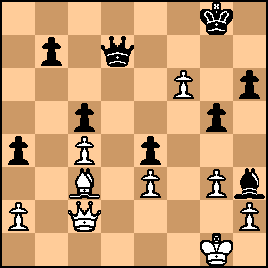
click for larger viewA difficult but probably not hopeless situation for Teichmann...at least until his next move: 27. Kf2?
Needlessly setting himself up for the following sequence by Albin. White could probably have held the game with 27. Qe2 or 27. a3 or even 27. Qd2. 27... Qf5+
28. Ke1
Obviously forced.
28... Qf1+
29. Kd2
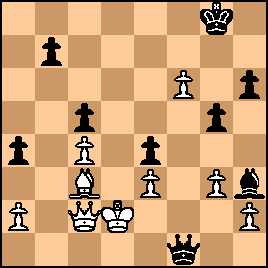
click for larger viewTeichmann was clearly in serious jeopardy here. But the move-30 time control approached, and both side erred badly both before the after move 30 was reached. |
|
Nov-20-22
 | | KEG: Post IV
29... Qxc4?
Sloppy. Either 29...Bf5 or 29...Bg4 would have kept Teichmann locked up. But now he had a chance: 
click for larger view30. Kc1?
30. Ba5! would have provided Teichmann counterplay perhaps sufficient to save the game. After the text, he was again very much on the ropes, and it soon got worse for him: 30... Kf7
Preventing Teichmann's Bishop from playing a more active role. 31. Be5 Qd5
32. Bc3
32. Bc7 and then if 32...Kxf6 33. Bb6 would offer more tenacious resistance. After 32. Bc3, the position was:
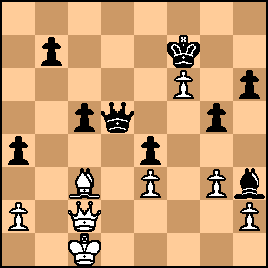
click for larger view32... b5?
Pursuing a plan that only bore fruit because of Teichmann's upcoming errors. 32...Be6 would leave little hope for White. After the text, Teichmann had a neat tactical chance. 33. a3?
Missing the boat. Instead, Teichmann should have played 33. Qe2! forcing Black to move either King or Bishop because of the nasty threatened fork of 34. Qh5+ Such tactics often arise with opposite color Bishops on the board. After 33. a3?, Albin was back in business:
33... Bg4!
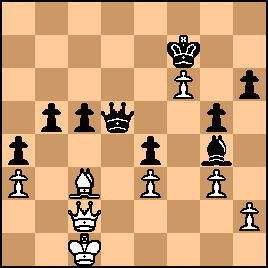
click for larger view34. Qd2?
After this lemon, Albin should have won with little difficulty. Teichmann had to play 34. Ba5 or 34. h3 here. The position was now:
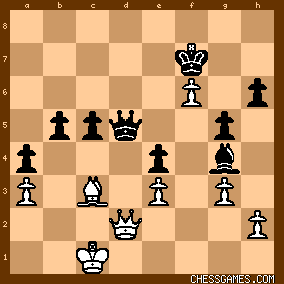
click for larger view34... Qc4
This may not blow the win, but simplest if 34...Qb3 which apparently was first spotted on this site four years ago by <Captain Hindsight>. But Teichmann failed to recognize his good fortune and played: 35. Kb1?
35. Qc2 was the best (and probably only legitimate chance. 35... Be6!

click for larger viewThings certainly looked grim for Teichmann, but strange things can happen in such positions...and they did here. |
|
Nov-21-22
 | | KEG: Post V
36. h4
Rather than wait to get overwhelmed, Teichmann decided to try to mix it up. While White has no theoretical way to save the day, Teichmann no doubt reckoned that he had to seek complications and hope he could reach a Bishop of opposite colors ending in which he was not too many pawns down. He also had to avoid getting checkmated. 36. g4 was another possibility that could also create difficulties for White but that theoretically loses to 36...Qb3+ or 36...Kg6. Back to the actual game after 36. h4:
36... Qb3+
37. Qb2
37. Bb2? would be even worse since Black can just play 37...b4! and White is dead. 37... Qd1+
38. Qc1
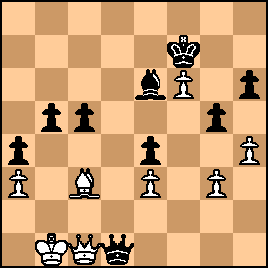
click for larger view38... Ba2+?
Making the win for Black more difficult. As the Tournament Book pointed out, 38...Qd3+ was best [39. Qc2 Qxe3; 39. Ka1 Qc4]. The text gave Teichmann a fighting chance:
39. Kb2 Qd5!
40. hxg5 hxg5
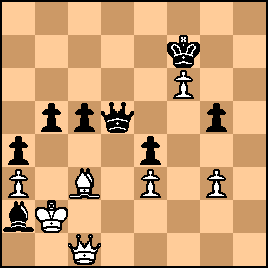
click for larger view41. Ka1?
Teichmann seemed to be wilting under the relentless pressure (and perhaps also because of the approach of the move-45 time control). 41. Qc2 Kg6 42. g4 was--objectively--Teichmann's only slim hope. After the text, Albin should have cleaned up: 41... Bb3
41...Bc4 also appears to win easily. But, as will be seen, the position was still tricky. 42. Qh1?
42. Qd2 looks like the only practical chance. Teichmann wanted the threat of invading the Black camp on the h-file. But removing his Queen from the defense of his King looks zany. But even after the text, there remained the chance that Albin, who was perhaps also short of time, would misjudge or get frightened by the prospect that the White Queen would attack. The position was now:
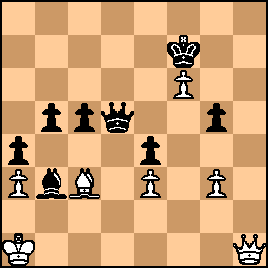
click for larger viewBlack now wins with 42...Qd3 e.g., 43. Bb2 [best, if 43...Qh7+ Ke6 44. Qe7+ Kd5 45. Qf7+ Kc6 46/ Qe8+ Kb7 after which White runs out of checks and gets wiped out) 43...Bc4 44. Bc1 Qc3+ 45. Bb2 Qxe3. But Albin somehow convinced himself that he could win by trading Queens, and so he played the disastrous: 42... Qd1+??
A terrible slip that allowed Teichmann to escape defeat. 43. QxQ BxQ

click for larger viewContrary to what Albin thought, White can survive this ending through a few neat tactical twists. 44. Be5
Now 44...b4 allows White to draw after 45. Bd6 b3 46. Bxc5 Kxf6 47. Kb2 Kf5 48. Kc3 Kg4 49. Be7 (indirectly protecting the White g-pawn). But Albin apparently had pinned his hopes on: 44... Ke6
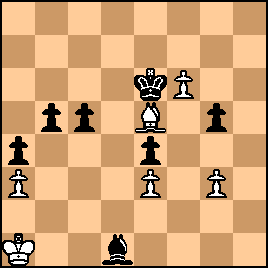
click for larger viewThere was, however, a simple refutation of Albin's idea: 45. f7!
45. Bc7 Kxf6 46. Bd6 c4 47. Kb2 reached the same position as in the game and also draws for White. 45... Kxf7
46. Bd6 c4
47. Kb2
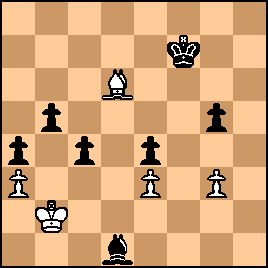
click for larger viewAlthough two pawns up, Albin discovered that White cannot win. The fact that opposite color endings such as this cannot be won is one of the unfairnesses of chess. But Albin should have considered this before playing 42. Qd1+? |
|
Nov-21-22
 | | KEG: Post VI
47... Ke6
48. Bb4
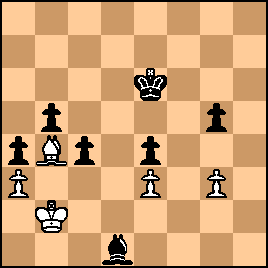
click for larger viewTeichmann's plan was simple and decisive for achieving a draw. The Bishop holds the Queen-side, and if Albin's King tried to harass the White pawns on e3 or g3 the White Bishop would go to e7 and pick up the Black g-pawn if left undefended. To this Albin had no answer. 48... Kf5
49. Kc3 Kg4
50. Be7
The key to Teichmann's drawing strategy:
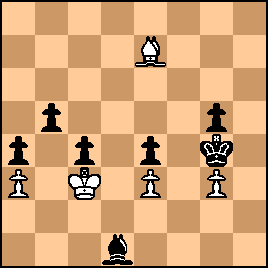
click for larger viewAlbin chose to play on from here, but White had no way to avoid the draw provided Teichmann kept his head. 50... Bb3
51. Bd8 Bd1
52. Be7 Kf5
53. Bd8 Bh5
54. Be7 Be8
55. Bd8 Kg4
56. Bf6 Bd7
57. Be7 Kf3

click for larger viewHaving made absolutely no headway, Albin decided to try something different--and set a couple of traps in the process. 58. Bxg5 Ke2
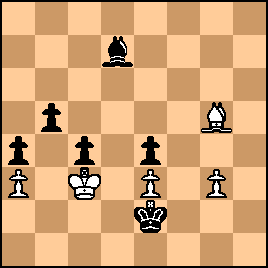
click for larger viewIf instead 58...Kxg3, Teichmann could draw by getting his Bishop to c5. The text had the merit of giving Teichmann a few chances to go wrong (though not much chance of that in this simple endgame). 59. Bh6 Be6
60. Bf4 b4+

click for larger view61. Kxb4
61. axb4? loses to 61...a3 62. Be5 a2 63. Kb2 Kxe3 64. Kxa2 c3+ 65. Kb1 Kd2 66. Bf4+ e3. 61... Kd3
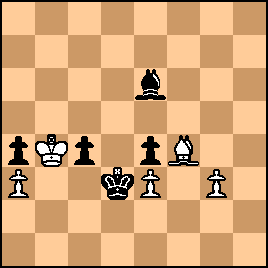
click for larger view62. Be5!
Forced. If 62. Kxa4?? Black wins with 62...c3 [e.g., 63. Be5 c2 64. Bb2 Kxe3 and one of the Black pawns must Queen. 62... Kxe3
63. Kxa4
Now this move can be made in perfect safety, the draw is obvious: 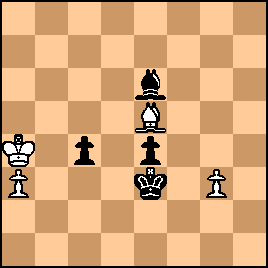
click for larger view63... Kd3
64. Kb4
Forced!
64... Bd7
65. Bc3 e3
66. Be1
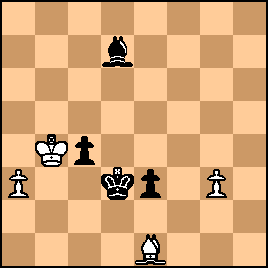
click for larger view66... Ke2
67. Bc3 Be6
68. a4 Kf2
69. a5 Kxg3
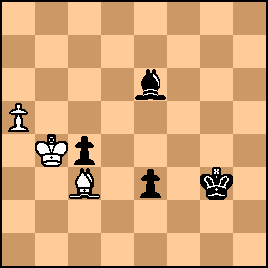
click for larger viewDrawn
The White Bishop deals with the Black e-pawn while the advance of the White a-pawn forces Black to leave his c-pawn undefended. A missed opportunity for Albin, who lost the replay (as White) eight days later and then lost the two games he played against Teichmann in later tournaments. |
|
|
|
|





































